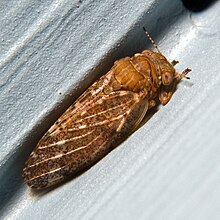This article includes a list of general references, but it lacks sufficient corresponding inline citations. (July 2011) |
| Psyllid | |
|---|---|

| |
| Hackberry psyllid – Pachypsylla sp.[1][2] | |
| Scientific classification | |
| Domain: | Eukaryota |
| Kingdom: | Animalia |
| Phylum: | Arthropoda |
| Class: | Insecta |
| Order: | Hemiptera |
| Suborder: | Sternorrhyncha |
| Superfamily: | Psylloidea |
| Family: | Psyllidae Latreille, 1807 |
| Genera | |
|
See text | |
Psyllidae, the jumping plant lice or psyllids, are a family of small plant-feeding insects that tend to be very host-specific, i.e. each plant-louse species only feeds on one plant species (monophagous) or feeds on a few closely related plants (oligophagous). Together with aphids, phylloxerans, scale insects and whiteflies, they form the group called Sternorrhyncha, which is considered to be the most "primitive" group within the true bugs (Hemiptera). They have traditionally been considered a single family, Psyllidae, but recent classifications divide the group into a total of seven families;[citation needed] the present restricted definition still includes more than 70 genera in the Psyllidae. Psyllid fossils have been found from the Early Permian before the flowering plants evolved. The explosive diversification of the flowering plants in the Cretaceous was paralleled by a massive diversification of associated insects, and many of the morphological and metabolic characters that the flowering plants exhibit may have evolved as defenses against herbivorous insects.
Several genera of psyllids, especially among the Australian fauna, secrete coverings called "lerps" over their bodies, presumably to conceal them from predators and parasites.[3]
- ^ Cirrus Digital Hackberry Psyllid
- ^ Bugguide.net Pachypsylla species
- ^ Oppong, C. K.; Addo-Bediako, A.; Potgieter, M. J.; Wessels, D. C. J. (2010). "Nymphal Behaviour and Lerp Construction in the Mopane PsyllidRetroacizzia mopani(Hemiptera: Psyllidae)". African Invertebrates. 51 (1): 201–206. Bibcode:2010AfrIn..51..201O. doi:10.5733/afin.051.0105.